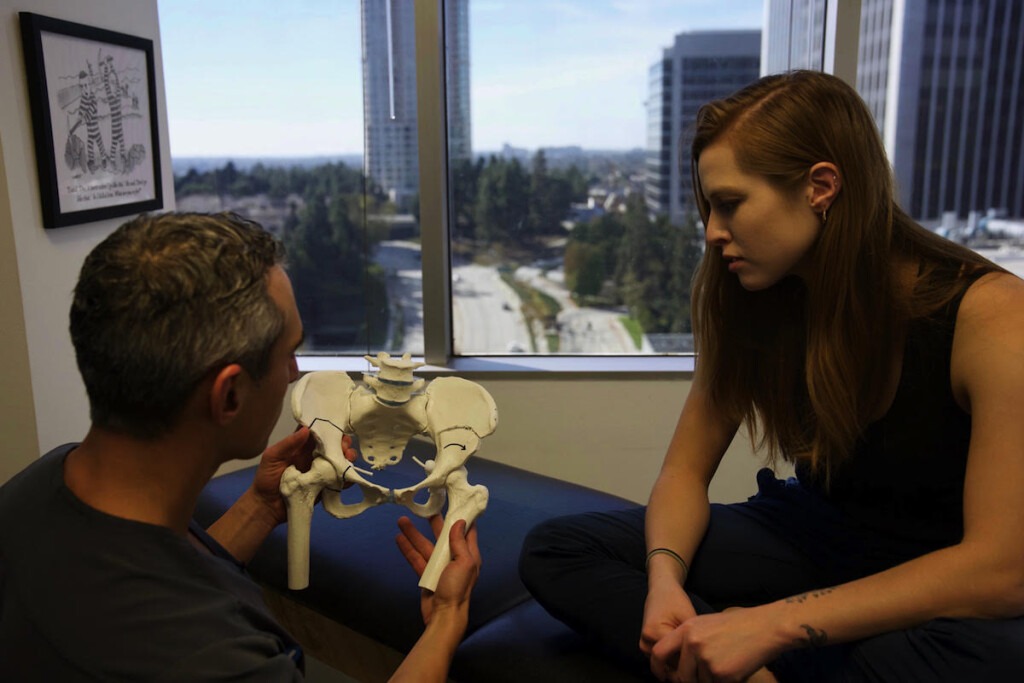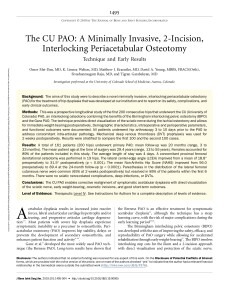What is PAO?
The term periacetabular osteotomy (PAO) refers to a procedure designed to treat hip instability (dysplasia). In dysplasia, the acetabulum (socket) is shallow and small resulting in inadequate bony coverage over the femur (ball) and excessive “play” in the hip joint (Figure-1A). If dysplasia is identified early in life (< 3 years of age), less invasive measures can be taken to encourage normal development of the socket. However, dysplasia that goes unrecognized until adolescence or adulthood is more difficult to treat given that the socket has solidified in its abnormally shallow/small state and can no longer be “molded” to be normal. Nevertheless, the painful instability that results from unrecognized dysplasia can still be treated by repositioning the deficient socket to a more optimal alignment, where it can better serve as a roof over the ball – a procedure that is called a PAO.

In dysplasia, the socket is too shallow to house the ball, giving rise to instability (A). A periacetabular osteotomy (PAO) restores normal joint mechanics by repositioning the shallow socket to a more optimal alignment (B).
How is a PAO performed?
All patients scheduled for a PAO first undergo a minimally invasive hip arthroscopy (performed 1 week prior to PAO) to address damage inside the hip joint. Following initial recovery from the hip arthroscopy, the PAO is performed under epidural anesthesia utilizing two well-concealed cosmetic incisions, each measuring approximately 3 inches in length. The socket is repositioned and stabilized using 2 to 3 internal metal screws (Figure-1B). The surgery typically takes 3 – 5 hours and patients remain in the hospital for 3 – 5 days. It is important to recognize that a PAO is a formal operation and not a “key-hole” surgery like hip arthroscopy.
What is the goal of PAO?
A PAO aims to achieve several goals including reduced pain, improved stability or confidence in the hip, and reduced risk of arthritis in years to come. The greatest benefit of a PAO is that it is joint preserving and enables you to keep your own hip joint rather than replacing it with metal and plastic. This means that after you have healed from the procedure, you can participate in any activity you like without restrictions.
Candidates for a PAO are typically in their adolescent or young adult years and a hip replacement surgery at such a young age would not only impose restrictions on post-operative activities, but would almost guarantee the need for a second and even third operation later in life to replace worn out parts. The risk of complications (persistent pain, infection, dislocation) with repeat joint replacement surgery can be significant.
Although a PAO is no guarantee that you will avoid a hip replacement later in life, it does enable you to enjoy your youthful years to the fullest, doing whatever you desire. And if a PAO can get you to 50 or 60 years of age before you potentially have to consider a hip replacement, that second surgery will likely serve you well for the rest of your life.
What is the typical timeframe for recovery from PAO?
It is important to realize that the speed of recovery depends largely on the extent and type of damage in the hip along with other patient related factors. Generally speaking, though, the majority of patients can expect to:
- Go home on post-operative day 3 – 5
- Resume normal daily household activities within 2 – 3 weeks
- Take prescription pain medication for 3 – 6 weeks
- Return to a desk-job with intermittent walking at 3 – 4 weeks
- Drive a car at 2 weeks
- Walk unassisted and without a limp by 3 – 5 months
- Start running at 4 – 6 months
- Return to unrestricted sports participation or a labor intensive occupation at 6 – 8 months
Will I need to do physical therapy following PAO?
Absolutely. Physical therapy is critical to ensure that you get the best outcome from your surgery. With the guidance of your therapist, you will progressively advance through the various stages of your rehabilitation, as outlined in our post-operative protocol. Your therapist will have some flexibility to safely modify your progression in order to meet your specific goals and expectations.
How successful is PAO?
The vast majority of scientific studies have produced good to excellent outcomes in 80 – 90% of appropriately selected patients undergoing PAO; with some studies reporting lasting benefits for up to 20 years post-operatively. The reproducibility of these results is dependent on many factors including age and degree of surface cartilage damage. Dr. Garabekyan will help you understand your unique condition and what you stand to gain with surgery, so that you can define realistic goals and expectations. At SCHI, your satisfaction is our priority.
Am I a good candidate for PAO?
Whether PAO is a worthwhile option for you depends on a number of factors, including:
- Your age
- Your particular diagnosis or pattern of injury
- The extent of arthritis or cartilage damage
In general, the outcomes of PAO are best in patients < 40 years of age with focal or discrete structural damage and minimal arthritis. Dr. Garabekyan will guide you through the various considerations in helping you decide whether PAO is right for you.
 Choosing the treatment option that is right for you involves careful consideration of your diagnosis, duration and severity of symptoms, desired level of activity, as well as social and financial elements. You are not alone in this process.
Choosing the treatment option that is right for you involves careful consideration of your diagnosis, duration and severity of symptoms, desired level of activity, as well as social and financial elements. You are not alone in this process.
As you research your condition, please write down all of your questions and bring them with you to your next appointment. Dr. Garabekyan and his team at SCHI will take time to address all of your concerns, until you are completely satisfied with your treatment plan.
We look forward to helping you get your life back.
Related Topics: Hip Instability (Dysplasia), Hip Arthroscopy






